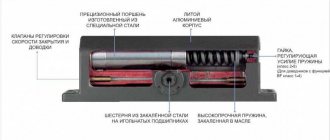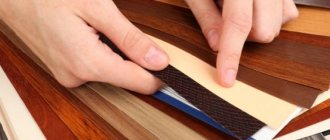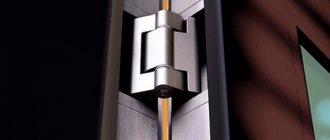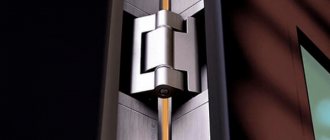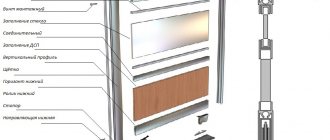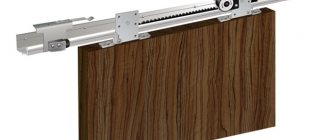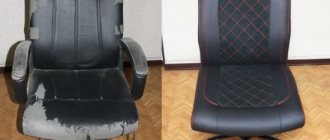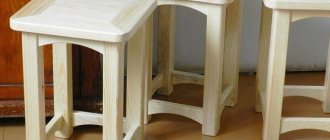A door closer is a mechanism that is designed to reliably close entrance doors. It presses the blade against the seals along the contour or creates the necessary force sufficient to trigger the lock latch. The door can close abruptly and with a sound, or smoothly and without making sounds, and can also pause.
Adjusting the door closer is a mandatory measure to extend the service life and maintain the performance characteristics of the mechanism.
It is subject to constant loads; frequent closing and opening of the door leads to imbalance of the elements of the device, and therefore requires periodic maintenance and repair, both for preventive purposes and if necessary.
When adjustment is necessary
In most cases, setting up and adjusting the closer can be done with your own hands. The initial adjustment of the mechanism is performed immediately after installation. Preventative inspections and elimination of minor faults are carried out 2-3 times a year.
How to adjust the door closer? The condition of the lubricating fluid is affected by the state of the environment. Structural parts are subject to constant thermal expansion and contraction. In winter, the oil thickens and the door speed slows down. In summer, the structure heats up and the doors close very quickly. Therefore, the main procedures are carried out during the changing seasons.
Adjustments are made during scheduled maintenance. During the setup process, the optimal parameters are established. With constant temperature fluctuations, the closers are adjusted more often - once every three to four months.
Significant temperature fluctuations destroy the mechanism, causing breakdowns and damage. At the first sign of malfunction, the device is checked. Oil leaks are eliminated and worn parts are replaced.
Important! In case of complex malfunctions, knowing how the closer is adjusted will not help solve the problem. In such cases, the device is returned for repair or replaced with a new one.
The frequency of scheduled maintenance is influenced by the service life of the equipment (old equipment breaks down more often), frequency of use, and the average value of constant loads.
How to adjust the door closer after installation
The function of a modern closing device is no different from the operation of the previous “antediluvian” springs, which were previously installed at the entrance to the front doors of residential buildings, organizations, and shops. Their big disadvantage was the sharp slamming of the door with a loud knock. Such a rapid closing of the front door was inconvenient and quite dangerous, especially for children, who could easily get their hands pinched. A modern door closer, its installation and adjustment, solve the problem of noise in the entrance, forcing the door structure to work in the prescribed mode.
The main working mechanism of any closer is a spring-loaded hydraulic shock absorber. Oil circulates from one chamber to another thanks to a system of valves that set the valve to move in different directions. The viscosity of the oil composition ensures smooth closing and opening of the door.
The closing device is installed indoors so that it cannot be removed from the outside. This protects the mechanism from dirt, dust, and also creates additional safety for residents. For installation you need instructions and tools:
- screwdriver;
- ruler;
- drill;
- pencil for marking.
The fasteners are included in the kit, which the manufacturers supplement with installation templates, which display all the components of the mechanism in full size and the location of the holes for fastening. Installation begins with fastening the housing, which is then connected to the traction lever. All steps are described in detail in the instructions, following which the installation is carried out quickly and without problems.
The device parameters, as well as adjustment methods, depend on the type of closing mechanism. There are two of them.
- Cam. The cam, as the main moving part, moves thanks to the rollers and presses on the spring, which smoothly guides the blade. The systems work well on lightweight doors.
- Serrated. The movement occurs due to a gear that transfers energy to a spring. The mechanism can be used for sashes with significant weight.
Depending on the location and method of installation, door closers are classified into one of three types.
- Floor. The name speaks for itself, the system is adjustable from below. The installation is carried out together with the installation of the door frame, planning in advance. The systems are used at the entrances to large buildings.
- Overhead. This is the most commonly used automatic closer. The device is installed on top, connecting the box and the canvas itself. Such mechanisms are always used for metal doors in residential buildings because they are easy to use and maintain.
- Hidden. This type of mechanism is rare. It is mounted directly into the door hinges or into the end of the door frame. Allows you not to disturb the interior of the room, is expensive, and has an increased degree of safety.
Selecting the door speed
After installation is completed, it is necessary to adjust the door closer so that the speed of door movement is most convenient during operation. Each device is equipped with special screws for adjusting the blade stroke. If it moves too quickly, it will be enough to turn the screw clockwise ½ turn. If the movement is too slow, turn the screw counterclockwise the same half turn.
Adjustment is carried out by trial until the speed is optimal. High closing speed is good for limiting the entry of strangers, insects and cold air. But for interior doors or kitchen cabinet doors, they usually set the movement to slow. This adjustment technique applies to all types of closers. The essence of the process is that the more the screws are tightened, the slower the oil flows from one cavity to another, the slower the system operates.
Installing the exhaust
When setting up the closer, special attention should be paid to adjusting the aftershock. This is the speed at which the door travels its final trajectory. When the high-speed slam is selected, it may slam shut with a loud noise, which destroys the box. Therefore, it is necessary to adjust the door closer so that the closing speed is low.
Setting the closing speed is similar to adjusting the general speed with the difference that the closing speed is provided only on the last 15-25 cm of the trajectory of the outer edge of the door. The higher the speed is set, the stronger the force of impact of the sash on the jamb. When choosing the passage speed at the end of the movement path, it is optimal to set the average value when closing is relatively fast, but without hitting the door frame. The aftershock is set by turning screw No. 2, which will adjust the movement of the canvas in such a way that the movement will first slow down, and then it will completely adjoin the jamb.
Calibrating the open position
In some cases, it is required that the doors be held open, for example, when furniture is being transported, or parents call a doctor to see their child, but there is no intercom. Adjustment of the “open door” mode in the door closer system is provided and performed simply.
Many models of top-mounted systems have a “hold open” option. To set the mode, you need to set the door at 90° and attach a special lock that will keep the door open as long as needed. If you open the sash to a different degree, the system will work without holding. When the need for open doors disappears, you need to pull the sash towards you, and the setting will be removed automatically.
Types of door closers
Manufacturers offer a wide selection of door closers. Such devices are classified according to their design features, operating mechanism, strength and other characteristics.
Depending on the installation location, the following types of door closers are distinguished:
- Invoices. Mounted on the top of the door. Attached to the door structure and wall. Ensures smooth movement of the sash when closing. These types of door closers are easy to install, operate and configure. At the same time, they are cheaper than other models. This mechanism is used most often today.
- Hidden. They come with a sliding rod. Can be included in canopies. In this case, they are responsible for opening and closing the door. Hidden mounting mechanisms require a sufficiently wide gap between the door frame and the leaf. Such devices do not last long and withstand little effort. Therefore they are rarely used.
- Floor-standing. They are represented by a lever that is connected to a spring, a piston and a roller that performs translational movements and drives the heart-shaped axis. This is an ideal option for swing doors and swing-type doors. Withstands heavy loads.
There are also door closers with a sliding channel, with a lever rod, and specialized ones. Such a wide selection allows you to choose a mechanism for any type of door block.
Adjusting the door closer during operation
A device that is installed and adjusted correctly guarantees flawless operation for a long time. However, the oil inside the mechanism reacts differently to changing weather conditions, which means the spring will compress differently. The characteristics of the system change after cold weather and manifest themselves differently in the summer heat. These are standard indicators, and you can adjust the door closer yourself without calling a specialist. The main thing is to do it in time and take into account some nuances:
- study the door closer instructions in detail, carefully following each step described;
- turn screw No. 1 counterclockwise ½ turn to adjust the reach;
- screw No. 2, turned ¼ turn clockwise, determines the opening speed;
- screw No. 3 (side) determines the force of movement of the sash.
Reasons for adjustment
As a result of prolonged use, any mechanism loses its original characteristics. Likewise, the closer, deviating from the settings, can close the sash very slowly or with a roar. Repairing the closer, carried out on time, and adjusting its mechanism will allow you to avoid more serious problems in the future. The reasons for adjusting the operation of the device may be the following events.
- Preventative checks of the entire system must be performed 1-2 times a year.
- In anticipation of low winter or high summer temperatures, prevention is mandatory. When temperatures fall or rise, the oil filler changes its properties, and the movement of the canvas slows down in winter. In the summer heat, the filler composition, on the contrary, liquefies and causes acceleration and impacts of the sash against the frame. Problems can be avoided by timely adjustment of the mechanism.
- When malfunctions occur, adjustments to the operation of the mechanism are especially necessary. If malfunctions are noticed, the damage should be inspected and repaired.
Tips: how to loosen a door closer
When users do not like the installed settings, the operation of the device is adjusted further. The closer can be adjusted using screws. If the door moves with difficulty, and considerable effort must be made, the screws should be loosened, and the door will work easily and smoothly. Fully loosening the screw allows you to keep the blade open when necessary.
Lever failure
The second malfunction that can also affect door closers is a malfunction or mechanical damage to the lever. If the closer breaks down for this reason, identifying the fault will not be difficult, since it will be visible visually. Most often, breakdown occurs under the following circumstances:
The process of adjusting the door closing speed
- deformation changes in levers;
- rust and corrosion of the metal surface of the rods;
- fracture or complete fracture of the lever;
- partial jamming of the mechanism associated with the fastening screw.
These closer breakdowns can be visually identified during an initial inspection of the mechanism. As a rule, the part is in a visible place, and identifying the cause of the appearance is not difficult.
Device and design of the closer mechanism
In this case, you can use the following troubleshooting options:
- If corrosion appears, the mechanism should be removed and its surface thoroughly cleaned of rust. After this, it should be covered with primer and paint, and then the structure should be returned to its original place. As a rule, after such actions the door closer will work like new.
- A break or fracture of the levers can be eliminated by welding or replacing these mechanisms with similar ones.
- If the cause of the malfunction lies in the mounting screw, then it should be unscrewed and the entire working surface thoroughly lubricated with grease, after which the screw is placed in its original place.
- If the levers are deformed or changed, they should be removed and carefully straightened to a smooth state. If this is not possible, then the parts will have to be replaced with analogues.
It is worth noting that careless use of the mechanism leads to breakage or other malfunction of the levers. To avoid this in the future, you should be careful with the mechanism and the doorway as a whole.
Limitations in adjusting the closer
In order not to damage the mechanism of the device, it is necessary to observe some restrictions:
- You cannot turn the screw more than two turns from the starting point, or oil loss will occur, all this will negatively affect the performance of the mechanism;
- During installation, distortions should not be allowed, otherwise the product will quickly become unusable;
- When the door is not fully open, you should not prop it up with foreign objects; you must use a special function;
- It is not allowed to place heavy objects on the door leaf, otherwise this may lead to a skew of the constructed diagonal.
Compliance with these rules will allow you to regulate the closer in a quality and timely manner, extending its service life using all its functionality.
Tips and tricks
In order for the mechanism to work correctly, certain measures must be observed:
- You should not prop the door with objects, because to fix the position it is enough to twist the screws.
- Before adjusting, you should read its instructions to become familiar with the permissible standards regulated by the manufacturer.
- When buying a mechanism, you should know the temperature conditions under which it will operate, because many models are designed for warm rooms.
- If a malfunction is detected, you should call a technician so that your actions do not aggravate the problem.
- The floor closer is installed at the door installation stage, which must be taken into account when purchasing the device.
The adjustment is carried out by carefully rotating the screws, because it is easy to disrupt the hydraulics, which will lead to a malfunction of the mechanism, which will be difficult or almost impossible to restore. Before setting up, you need to make sure that the reason for the poor operation of the device is in the closer.
Setting the intermediate stroke
Usually the intermediate stroke is adjusted in unison with the main door stroke, but there are other options. For example, if you need to slightly reduce the speed halfway through the door closing. To do this, use the third adjusting bolt. This bolt serves to hold the door leaf in a certain position. For example, you need to add more closets to your apartment.
The screw can be adjusted so that the door remains open for a while, and only then begins to close.
Signs of malfunction and causes of failure
We must not forget that the door closer is a complex device. Therefore, repairing it is not always possible. In some cases, it is, of course, possible to repair it - but it will be very expensive. Frequent defects are:
leakage of working fluid;
If the closer opens slowly, it needs to be adjusted. A pair of screws are used for this purpose; both need to be adjusted strictly to your needs. Damage may be due to harmful weather conditions. If the temperature constantly changes, if it snows or rains, if the air contains a lot of dust, the structure can easily fail. When the closer does not work or works hard, the breakdown may be due to improper use of the device.
Common mistakes are:
securing the canvas in the open position;
opening the door at an unacceptable angle;
excessive force when opening or closing;
insufficient care of the door closer.
In winter, the operating speed of the closer decreases, and in hot weather it increases. This is due to a change in the viscosity of the working oil. Therefore, when the season changes, additional adjustment of one of the valves is required. If the door closer does not close the door completely, you must first follow the instructions. Along with adjusting the speed, it is often necessary to adjust the intensity of the clap - tighten the spring.
In some cases, the problem is associated with insufficient strength of the device itself. If this is the case, no adjustments will help. Yes, tightening the spring will then give a positive result, but the shelf life of the product will be reduced. It would be much better to purchase a more powerful door closer and replace the existing one. It is important to consider that problems can also be associated with errors during the installation of closers, as well as doors in general.
How to increase service life
There are a few simple tips that, when followed, eliminate the possibility of mechanical breakdowns and extend the life of the devices.
- Always take into account the conditions for using the door closer. If it is installed on the doors of public buildings, the frequency of opening/closing increases sharply. In addition, not all visitors handle doors carefully; strong mechanical stress may occur. For such needs, you need to choose the most reliable door closers. Attention is drawn secondarily to the number of adjustments; the main factor is mechanical stability.
When choosing a model, it is necessary to take into account the loads to which the closer will be subjected
- Make sure that the door is used for its intended purpose and does not serve as a barrier for animals, a toy for children, etc. There is no need to increase the weight of the door leaf. We have already mentioned that the greater the weight of the doors, the higher the inertia indicators, and they have an extremely negative effect on the mechanism.
Closers for heavy doors
- Never undertake installation or adjustment of the device without reading the instructions, without understanding the principle of operation of the closer elements, and without foreseeing the possible consequences of your interventions.
You can start adjusting the closer yourself only after studying the instructions
- Do not buy mechanisms from unknown companies. The fact is that they have many connections that require high precision machining of the surfaces of the parts. At the slightest deviation in technology, oil leaks appear. It is impossible to correct the problem by simply adding oil; complex repairs must be made. This requires a lot of time and money, and the result is still unknown. It is much more profitable to immediately buy expensive but high-quality goods from well-known European class=”aligncenter” width=”737″ height=”590″[/img]
Door closers from well-known brands are of high quality and have a long service life.
Find out how to repair the door handle of a metal door with your own hands in a special article on our portal.
Oil leakage
A very common reason when a door closer needs to be repaired. In this case, the oil liquid that fills the working mechanism completely or partially leaks out, which leads to sudden operation of the spring and a corresponding slamming of the door. Such a malfunction can occur if the device is used for a long time without proper adjustment according to the instructions.
Door closer adjustment diagram
The design of the door closer includes small recesses where there are adjusting screws; if they are broken or incorrectly adjusted, oil fluid may leak out through these holes.
If the speed of movement of the structure is too sharp or excessively slow, then you should pay attention to these parts; when oil leaks out, characteristic oil stains will be visible on them.
Is it possible to repair door closers if oil leaks? If a small part of it has left the device, then this is possible if there is a complete absence of fluid from the part of the closer responsible for smooth operation, then repair is not advisable. In this case, it will be much easier to purchase the same model of door closer, but without mounting levers; it will cost significantly less. If there is a slight leakage of liquid, it must be added in the required amount. To do this, the structure is completely dismantled. Oil is poured through a special hole.
How to make adjustments
Depending on what we want to do with the door (slow down, speed up), there will be a sequence of actions. There are a total of two screws on the door closer on the side panel. The first top one is responsible for the speed of the canvas slamming. And the lower one is responsible for the speed of movement of the sash after it is fully swung open.
First you need to completely open the canvas and let it slam shut on its own. Monitor the speed of movement of the sash and its noise and sharpness when closing. Does the sash hit the frame hard? If yes, then you need to adjust the whole process.
So, in order to increase the speed of movement of the blade when closing, we adjust the lower screw. Do we want to increase speed? Turn the screw counterclockwise. Let's check. As a rule, it is enough to turn the screw half a turn. This is often enough. After adjustment, we check the operation of the door. If everything suits you, we leave it as is. If the door moves too quickly, turn the screw in the opposite direction a quarter turn. And accordingly, if we want to reduce the speed of the web, then turn the screw clockwise.
Now we are working on the finishing touches. If the door hits the frame hard when closing, turn the top screw. Try turning it half a turn and again track the speed of the clap. If everything is fine, leave it as is. If the door does not tighten tightly, then loosen the screw a little. The door should fit into the frame evenly, moderately tightly, without a strong bang, and especially without distortion. By turning the screw you can achieve the desired position of the sash.
By the way, when adjusting the speed of the blade, you can set it to the fully open position if necessary, for example, when moving and carrying large items back and forth. To do this, open the door completely and turn the bottom screw clockwise. It will remain in the open position for the required period of time. Then return the adjusting screw to the reverse position.
Please note that if the door is clearly skewed and does not fit tightly into the frame, you should not try to straighten it yourself. Here you will need the help of a professional who will find out the cause (deformation of the canvas or imbalance of the hinges) and eliminate it.
Interesting: Hole in linoleum: how to repair it
For more information on how to adjust the door closer at the entrance, watch the video in our material. And remember the prohibition on turning the screws too hard. Oil filled in at the factory cannot be restored at home. Hydraulics is a complex matter.
Step-by-step adjustment instructions
For example, we will consider only one model of mechanisms. Having studied the algorithm of work, you will be able to regulate other types; they have no fundamental difference in design, the differences are only external.
Step 1 . Remove the decorative housing cover. It is fixed with latches; to release it, just pull it towards you.
Step 2 . Adjust the long rod; it should be positioned strictly parallel to the channel. The adjustment is done in several stages.
- Loosen the rod securing screw one or two turns. It is located at the bottom of the case; the fasteners are unscrewed with a hex key.
Practical advice. For better compression, the rod should be set at an angle of approximately 8° to the channel. Due to this position, the spring is further compressed, and a constant force is applied to the door leaf.
Step 3 . Attach the rod to the sliding channel. It must be pressed, rotated 8°, and the cutout must be hooked onto the technological protrusion. Use a hex key to tighten the fixing screw. Check the functionality of the doors - if they hit the frame with great force, then additional adjustments need to be made.
Step 4 . Adjust the speed of closing the canvas. This is done with screw “C”; when you tighten/unscrew it, the throughput of the hole changes. There is a valve at the bottom of the screw that controls the degree to which the hole is closed. Achieve the speed you need; adjustments will have to be made several times to achieve the desired effect.
Step 5 . Using the “L” valve, adjust the closing speed before touching the box. This parameter eliminates loud claps of the blade, reduces the load on the lock, and increases the service life of the elements. The final closing speed should be approximately two times less than the main one.
Step 6 . The opening force is regulated by the bottom valve “B”. This so-called brake does not allow drafts, animals, or small children to open the doors. Another task of the brake is to limit the maximum opening and prevent sudden shock loads on the mechanism.
Step 7 . Modern devices have a very important function - closing delay. The doors remain open for some time, during which time people in wheelchairs enter the room, parents with small children and strollers, and the elderly calmly enter. The function is regulated by valve "D". Achieve the required closing delay by changing the size of the passage opening. The smaller its area, the less oil it lets through, the longer the delay.
Consequences of improper use
Despite the fact that high-quality devices have fairly high durability, they also sometimes experience premature failure.
If used incorrectly, even high-quality door closers fail
- Mechanical breakdowns of the closer: deformation of the rods, disruption of the functionality of the piston. Such breakdowns appear as a result of improper use of doors and excessive physical effort on the door leaf.
- There are situations when mechanisms use oil that is not intended for operation at sub-zero temperatures. It sharply increases viscosity, doors open/close with difficulty, and great physical effort is required.
- Sealing failure and oil leakage. The seals cannot withstand the pressure and burst. When using the doors, oil gradually leaks and air takes its place. In addition to deteriorating the appearance of the doors, the performance of the door closer is impaired.
- Installation of a rigid closer on plastic doors. These structures cannot withstand significant forces, the elements of the door frame become loose over time, and the mechanism body falls with all the extremely negative consequences.
The type of closer must match the door design
We remind you once again that the duration of use of the door closer largely depends on the consumers. If they follow all the manufacturers' recommendations, then no unexpected problems will arise.
Video - Adjusting the door closer according to closing force
Design features of the device and adjustment progress
Adjusting the door closer is impossible without a clear understanding of the principle of operation of the mechanism. The closer is a spring combined with rollers and pistons or with a gear mounted on a rack. When the door opens or closes, the mechanism comes into action, collecting or, conversely, opening the spring. At the same time, the vacated cavity is filled with oil. The combination of hydraulics and mechanics results in a reliable and simple device that does not require additional maintenance other than careful handling.
What to do if nothing works out?
There are several reasons why the setup may not produce results:
- An inappropriate mechanism has been selected, the door is too heavy, and heavy objects are frequently hung on the door leaf.
- Incorrect fastening of the iron angle, misalignment of parts.
- Displacement of the holes for the screws on which the device is attached, unscrewing.
If one of the above points applies, then there are only two options - change the door, install a different closer. There is a third option - try to fix it yourself, but lack of experience can lead to worsening.
The lever must be positioned strictly perpendicular to the canvas, otherwise one of the parts must be moved.
Why can't I install a door closer?
Sometimes, having prepared well for installation and carried out everything in accordance with the manufacturer’s instructions, it is not possible to complete the installation. The reason for failure may be the incorrect selection of parts.
Don't miss: How to disassemble a door handle?
Currently, there are many models of door closers produced for different types of door leaves. This especially often occurs when selecting a mechanism for metal doors. Perhaps the angle for securing the mechanism was set incorrectly, or the holes in the screws were displaced. Also, the purchased design may not match the width and weight of the canvas.
Sometimes, to successfully install a door closer, you need to move one link. To check, look at the evenness of the lever - if the position is not perpendicular to the doors (displacement), the link will need to be moved.
If, when checking the installation of the angle and displacement of the holes, no deviations are identified, then a complete replacement of the device will be required. You will need to select a closer with more power.
